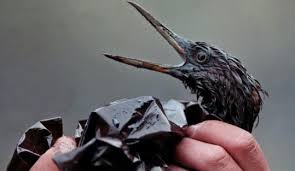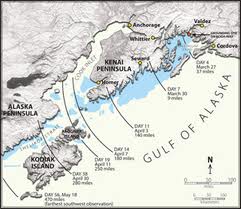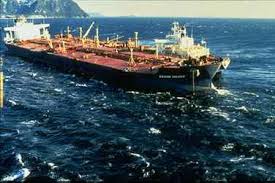The legacy of the Exxon Valdez disaster
Last March was the 25th anniversary of one of the worst environmental disasters in U.S. history: the Exxon Valdez oil spill. It was such a huge leak that it permanently changed the policies of the U.S. Government about shipping oil in U.S. waters, and changed the attitude of many Americans about the risks of huge, hard-to-maneuver supertankers operating in close to shore. More importantly, it galvanized the environmental movement for many years, and forced many Americans to reassess our voracious consumption of oil (even though this was Alaskan oil, not foreign oil). Among U.S. oil spills, only the 2010 BP Deepwater Horizon oil spill was worse in terms of total amount of oil leaked into the ocean.
The facts of the disaster are mostly straightforward. Near midnight on March 24, 1989, the gigantic oil tanker Exxon Valdez was carrying 55 million gallons of crude oil, pumped from up in Prudhoe Bay, Alaska, and then shipped from Valdez Harbor, on its way to Long Beach, California. As it was maneuvering through the rocky waters of Prince William Sound, only the third mate was awake and in control of the ship, and he was sleep-deprived. At 12:04 a.m. in the dead of night, the ship hit Bligh Reef, tore a huge hole in the hull, and immediately began leaking hundreds of barrels of oil.
As soon as the disaster struck, everyone was pointing fingers of blame in all directions. The captain, Joseph Hazelwood, was snoozing in his bunk at the time, apparently sleeping off the effects of heavy drinking. The second mate was also asleep (but supposed to be on duty), so it fell to the third mate to pilot the ship, even though he was alone and sleep-deprived. Naturally, Exxon wanted to put all the blame the captain, but there were many other culprits. The NTSB found that Exxon was negligent in failing to enforce policies that at least two officers be awake and active while piloting the ship, and that their work schedule was so grueling that none of the officers had proper rest. They also found that the ship has a sophisticated radar system on board that would have detected the reef, but it was broken for over a year, and Exxon decided it was too expensive to fix. As reporter Greg Palast wrote in 1999:
“Forget the drunken skipper fable. As to Captain Joe Hazelwood, he was below decks, sleeping off his bender. At the helm, the third mate never would have collided with Bligh Reef had he looked at his RAYCAS radar. But the radar was not turned on. In fact, the tanker’s radar was left broken and disabled for more than a year before the disaster, and Exxon management knew it. It was [in Exxon's view] just too expensive to fix and operate.”
A later analysis pointed out that:
- Tanker crews were not told that the previous practice of the Coast Guard tracking ships out to Bligh Reef had ceased.
- The oil industry promised, but never installed, state-of-the-art iceberg monitoring equipment.
- Exxon Valdez was sailing outside the normal sea lane to avoid small icebergs thought to be in the area.
- The 1989 tanker crew was half the size of the 1977 crew, worked 12–14 hour shifts, plus overtime. The crew was rushing to leave Valdez with a load of oil.
- Coast Guard tanker inspections in Valdez were not done, and the number of staff was reduced.
- Lack of available equipment and personnel hampered the spill cleanup.
Wherever the blame lies, the effects were horrendous. The remoteness of the location made it very difficult for the oil companies or the Coast Guard to mount much of a response until almost 3 days had passed, so the oil soon spread over 1300 miles of coastline and 11,000 square miles of the ocean surface. Before it was all over, at least 11 million barrels were spilled out across the Sound. Eventually, the ship was floated again, and it returned to port to offload its remaining 44 million gallons of oil, then limped to San Diego where it was repaired. Exxon was widely criticized for its slow response, but eventually there were about 11,000 people (both Exxon employees and volunteers) trying to skim the oil from the surface, burn what they could of the floating oil, and then using high-pressure hoses to wash the oil off the shorelines. At first they used hot water in the hoses until it was pointed out that hot water was killing more wildlife (especially plankton) than they would by using cold water. Exxon tried using dispersants to break up the oil, but then people realized that these chemicals also degraded the natural oils in the feathers of seabirds, so the healthy birds died without their protective layer of waterproof feathers. Altogether, the spill caused the deaths of as many as 250,000 seabirds, at least 2,800 sea otters, approximately 12 river otters, 300 harbor seals, 247 Bald Eagles, and 22 orcas, and an unknown number of salmon and herring and other fish. The cleanup effort went on for several years, and Exxon had to pay about $2 billion in cleanup costs, $1 billion to settle lawsuits with all the people who lost their fishing industry or tourist jobs, and over half a billion in punitive damages (originally assessed at over $4.8 billion, but reduced by later court decisions).
The disaster had many consequences. In 1990, Congress passed the Oil Pollution Act, which strictly regulated the size and crews and schedules of oil tankers operating in American waters, and demanded that all future tankers be built with double-hulled construction, with no single-hulled ships allowed by 2015. The Governor of Alaska demanded that every large tanker have two tugboat escorts with it until it reached the open sea. The fishing and tourism industries collapsed in Prince William Sound, and the fishing for most seafood there has still not recovered. As the 25th anniversary passed last March, a series of reports were issued about how the region had recovered in a quarter century. There are still almost 23,000 gallons of oil lying in the sand and seafloor of Prince William Sound, since the oil degrades very slowly in that cold water, at only about 4% per year is broken down. The sea otters and orcas seem to have recovered, but many other animal populations have not. Federal scientists estimate that between 16,000 and 21,000 gallons of oil remains on beaches in Prince William Sound and up to 450 miles away. Some of the oil does not appear to have biodegraded at all. A USGS study reported that ” it remains among rocks and between tide marks. The oil mixes with seawater and forms an emulsion…Left out, the surface crusts over but the inside still has the consistency of mayonnaise – or mousse.”
But the larger effect of the Exxon Valdez disaster was a huge response of anger and indignation against the oil companies, and horror for all the dying wildlife and despoiled nature of pristine Prince William Sound. Public outcry was so great that Congress moved much quicker than usual to put in regulations, against the wishes of the powerful oil lobby. Environmental groups saw increased vigor and donations as people were shocked into noticing how dangerous and vulnerable our oil supply line had become. But in other respects, the response was inadequate. Very few people saw this as a sign that their precious supply of oil was getting harder and harder to transport safely, and almost nobody acted on the many calls for reducing our oil consumption and making such risky means of transport necessary. Now we’ve had almost the same debate over the disastrous 2010 Deepwater Horizon oil spill, which was far worse—but the political effects were much less than those caused by the Exxon Valdez disaster. Or the current debate over the Keystone XL pipeline further illustrates the public confusion and lack of understanding and wise considerations of what that pipeline will really do (mostly bring Canadian oil to Gulf ports for shipment abroad, NOT for American use), or whether such a pipeline can be run safely (numerous accidents and leaks happen all the time on nearly every pipeline).
Now we are facing worldwide shortages of cheap oil, and the only oil we’re finding is more and more expensive to produce. But the shock of one oil spill after another doesn’t seem to make Americans rethink their outrageous consumption rates of 21 million barrels a day, the most wasteful in the world. Only the inevitable pressures of higher global oil prices as China and India and other underdeveloped nations begin to demand their fair share are enough to push the price at the pump over $4 a gallon, and make us abandon Hummers and go to hybrids.





Your last paragraph seems to express surprise that many people are basically short-sighted and selfish. Yet you’re an evolutionary biologist. Now I’m surprised.
No, I”m aware of how irrational humans are, as well as short-sighted and selfish. That’s a main theme of this site. But I like to at least PRETEND that we can be rational, and TRY to be optimisitic–because there are times when humans do the right thing…
A really interesting article, and I hate to nitpick, but you’ve made what I’m assuming is a typo in the paragraph starting “The disaster had many consequences”. The Oil Pollution Act was passed in 1990, not 1980.
Oops! Sorry! Fixed now
TXS for this article. More people need to really understand the implications of the potentially future Canadian/Keystone etc. oil going across our country and that it isn’t not even for America’s use.
And this really seems weird to ordinary people (me) to say the least, as we continue to buy and be impacted by overseas oil.
Perhaps that isn’t a topic for this website?
I blog about a wide range of scientific topics, which is the mandate for this site focused on science and skepticism. I’ve talked about oil before, as well. And as a geologist and paleontologist, my posts tend to focus on topics related to those fields.
Um… I meant that the topic of where/why the oil is going to another country after traveling literally across-this-country (while we continue to buy more oil from other countries) may not be an appropriate topic for this website. Or is it?
It could be worse, imagine if internal combustion engines ran on glitter. That crap invades everywhere and you can never get rid of it all.